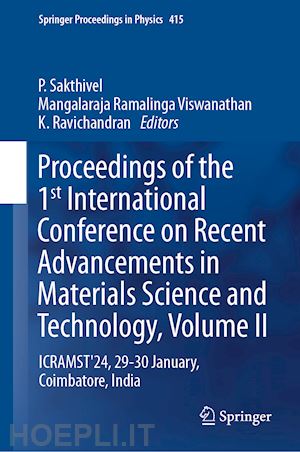
Questo prodotto usufruisce delle SPEDIZIONI GRATIS
selezionando l'opzione Corriere Veloce in fase di ordine.
Pagabile anche con Carta della cultura giovani e del merito, 18App Bonus Cultura e Carta del Docente
This book presents peer-reviewed and selected papers from the 1st International Conference on Recent Advancements in Materials Science and Technology held at Karpagam Academy of Higher Education in Coimbatore, India, on 29-30 January 2024. Experts across the world share the latest developments in their respective fields within materials science, including nanomaterials, biomaterials, optical materials, construction materials, composite materials and more. Additionally, addressing sustainability and the importance of international collaboration, this book serves as an up-to-date and effective resource for researchers, academics, industrialists, and students looking to understand the state of numerous materials science subfields.
Chapter 1: Experimental Invetigation Of Carbon Short Fibres Reinforced With Ai 6061- Zr02 Hybrid Metal Matrix Composite Using Stir Casting Method.- Chapter 2: Experimental Investigation Of Al8011 Reinforced With Zro2 Hybrid Metal Matrix Composite Based On Wear.- Chapter 3: Effect Of Boron Carbide And Graphite Particle On Coefficient Of Friction In Hybrid Aluminium Metal Matrix Composite.- Chapter 4: Preparation, Thermal And Antioxidant Properties Of Aminoguanidinium 2,3-Pyrazine Dicarboxylates.- Chapter 5: Flow Analysis Of Injection Molded Brake Shoe For The Metal To Plastics Conversion.- Chapter 6: Tribological Study Of Aa6061 Based Hybrid Composite Reinforced With Graphene, Tio2, And Sic Fabricated By Hot Isostatic Pressing.- Chapter 7: Experimenting Electrophoretic Deposition Of Zein/Ha Composite Coating On Mg Az31B Alloy For Biomedical Application.- Chapter 8: Effect Of Fiber Length On The Mechanical Properties Of Unsaturated Polyester Composites Enhanced By Chemically Modified Borassus Stalk Leaf Fiber.- Chapter 9: Design And Analysis Of Wing Spar To Enhance The Fatigue Life.- Chapter 10: Experimental Study On Ultra High-Performance Concrete Subjected To Various Loading.- Chapter 11: Study On Flexural Behaviour Of Reinforced Concrete With Polypropylene And Crimped Steel Fibers.- Chapter 12: Effect Of Long Basalt Fiber On Flexural/Tensile/Impact Strength Behaviour Of Low-Density Polyethylene Composite.- Chapter 13: Polyethylene Composite Is Fabricated With Nano Sic And Short Basalt Via Advanced Injection Mold Route: Performance Measures.- Chapter 14: Bast Fiber Loaded Of Low Density Polyethylene Composite Prepared Via Compression Mould: Performance Evaluation.- Chapter 15: Enrichment Of Functional Behaviour Of Ldpe Hybrid Nanocomposite By The Combinations Of Short Fiber-Nano Ceramic.- Chapter 16: Experimental Investigation Of Spindle Speed And Feed Influence On Cylindricity Tolerance While Drilling Aluminium6061 Mmc Filler With 15%Weight Percentage Of B4C And In Comparison With Cast Aluminium6061.- Chapter 17: A Study On Compressive Tensile And Hardness Properties Of Aluminium 6061 With 5-15% Boron Carbide Reinforcements.- Chapter 18: Effect Of Fiber And Orientation Performance Of Bamboo/Pp Fiber Composite Using Response Surface Methodology.- Chapter 19: Impact Of Sio2 Performance On The Composite Reinforced With Bamboo/Kenaf Fibers.- Chapter 20: Effect Of Fiber And Orientation Performance Of Glass Fiber Composite Using Response Surface Methodology.- Chapter 21: Residue To Resource: A Review On Examining Applications And Challenges In Reusing Grinding Sludge.- Chapter 22: Experimental Investigation Partial Replacement Of Coarse Aggregate With Pumice Stone And Polypropylene Fibre.- Chapter 23: Analysis And Quantification Of Microplastics And
Effect Of Catalyst On Sludge.- Chapter 24: Design And Analysis On Coconut Peeling Machine.- Chapter 25: Machine Learning Approaches To Classify Indian Mango Varieties.- Chapter 26: Investigation On Wedm Machining Of Al/Al2O3/Mwcnt Nanocomposites And Parameter Optimization Using Moora Technique.- Chapter 27: Enhancing The Mechanical Strength Of Dissimilar Friction Stir Welded Joints Using Parametric Optimization.- Chapter 28: Low-Cost Solar Still With Natural Storage Materials – An Experimental Investigation.- Chapter 29: A Brief Review On Cogeneration Of Energy And Water With Integration Of Solar Photovoltaics To Single Basin Solar Stills.- Chapter 30: Experimental Investigation Of Nano Hexagonal Boron Nitride Reinforcement In Aluminium Alloys Through Casting Method.- Chapter 31: Performance Evaluation Of Natural Adsorbent In Treating Textile Wastewater.- Chapter 32: Optimizing Friction Stir Welding Parameters For Improved Aa6061 And Az31 Mg Alloy Joints.- Chapter 33: Exploratory Research On Flexural Beam Using Magnetized Water.- Chapter 34: Comparative Study Of Characteristics And Applications Of Aluminium Alloy Series.- Chapter 35: Recent Advances In Ai-Powered Drug Discovery: Leveraging Machine Learning For Mechanism Of Action Prediction.- Chapter 36: Certain Investigations On Machine Learning Models For Material Processing.- Chapter 37: Experimental Assessment Of Eco-Sand-Infused Glass Fiber-Reinforced Concrete.- Chapter 38: Experimental Study On Concrete With Partial Vermiculite And Fly Ash Replacement Of Fine Aggregate And Cement.- Chapter 39: Investigation Effect Of Alkaline Treatment On Me-Chanical Behaviour Of Agro-Waste Filler Reinforced Polymer Matrix Composite.- Chapter 40: A Chemical Approach: Disposal Of Solar Panel.- Chapter 41: Optimizing Single Slope Solar Stills For Enhanced Freshwater Production: A Study On Efficient Energy Storage Using Sensible Heat Materials.- Chapter 42: Optimization Of Process Parameter For Passive Type Double Slope Solar Still -Taguchi Method.- Chapter 43: Corrosion Inhibition Studies Of Furan Based Schiff Base On Aa6351 Frictional Surfaced Mild Steel.- Chapter 44: Experimental Analysis Of Hexagonal Basin Solar Still.- Chapter 45: Optimization Of Friction Stir Process Parameters For Fabrication Of Surface Hybrid Composite Using Full Factorial Design.
Prof. P. Sakthivel’s areas of expertise are nanomaterials synthesis, characterization techniques, electronic and optical materials for optoelectronic applications.
Prof. Mangalaraja Ramalinga Viswanathan’s research interests are focused on nanotechnology-driven advanced materials for energy and environmental applications.
Prof. K. Ravichandran has published 180 research articles in SCI-indexed journals and his research interests are nanomaterials and TCO films.











Il sito utilizza cookie ed altri strumenti di tracciamento che raccolgono informazioni dal dispositivo dell’utente. Oltre ai cookie tecnici ed analitici aggregati, strettamente necessari per il funzionamento di questo sito web, previo consenso dell’utente possono essere installati cookie di profilazione e marketing e cookie dei social media. Cliccando su “Accetto tutti i cookie” saranno attivate tutte le categorie di cookie. Per accettare solo deterninate categorie di cookie, cliccare invece su “Impostazioni cookie”. Chiudendo il banner o continuando a navigare saranno installati solo cookie tecnici. Per maggiori dettagli, consultare la Cookie Policy.